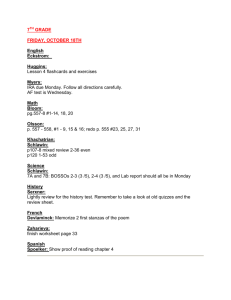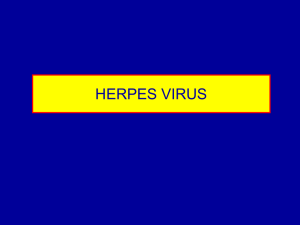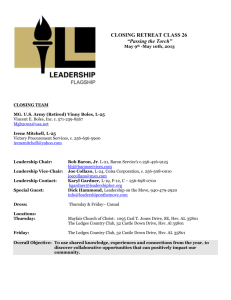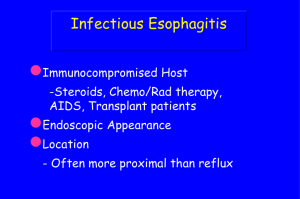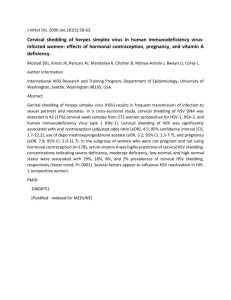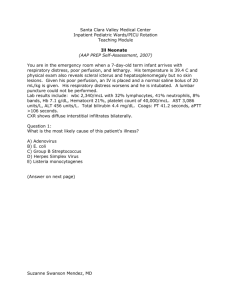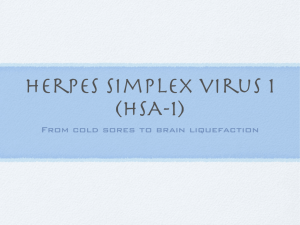ANTIVIRAL AGENTS Antiviral Agents John A. Bosso, Pharm.D.
advertisement
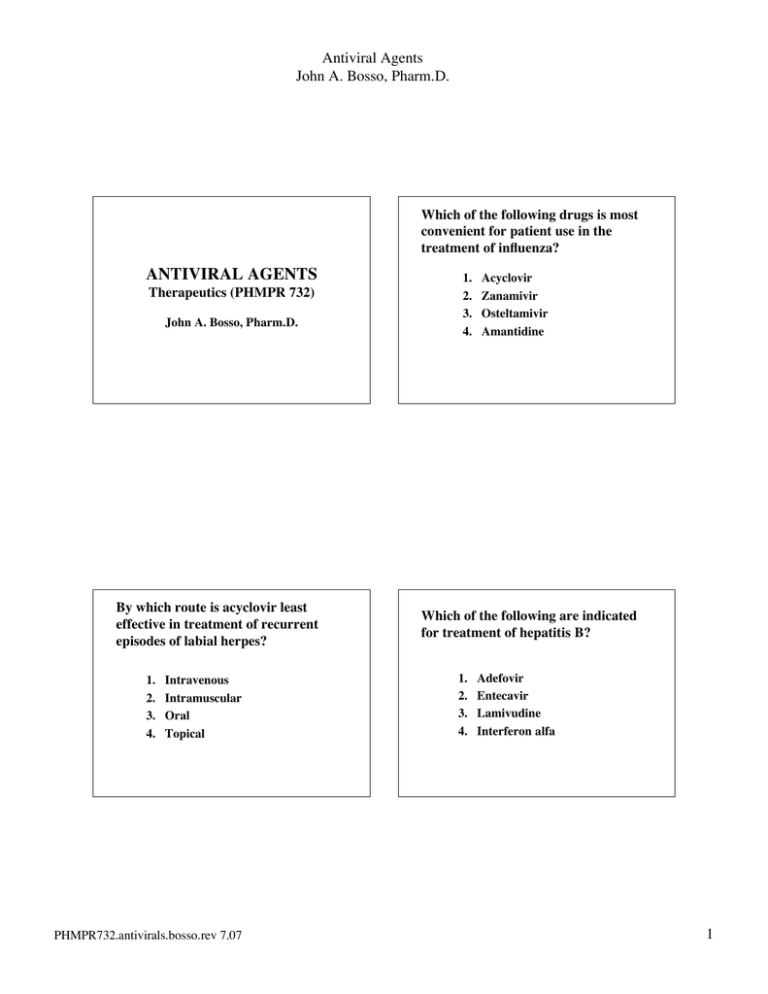
Antiviral Agents John A. Bosso, Pharm.D. Which of the following drugs is most convenient for patient use in the treatment of influenza? ANTIVIRAL AGENTS Therapeutics (PHMPR 732) John A. Bosso, Pharm.D. By which route is acyclovir least effective in treatment of recurrent episodes of labial herpes? 1. 2. 3. 4. Intravenous Intramuscular Oral Topical PHMPR732.antivirals.bosso.rev 7.07 1. 2. 3. 4. Acyclovir Zanamivir Osteltamivir Amantidine Which of the following are indicated for treatment of hepatitis B? 1. 2. 3. 4. Adefovir Entecavir Lamivudine Interferon alfa 1 Antiviral Agents John A. Bosso, Pharm.D. Classification of Viruses DNA-viruses RNA-viruses: 1 RNA-viruses: 2 PHMPR732.antivirals.bosso.rev 7.07 2 Antiviral Agents John A. Bosso, Pharm.D. Purine Nucleotides • • • • • • • • Acyclovir (Zovirax) Valacyclovir (Valtrex) Famciclovir (Famvir) Penciclovir (Denavir) Ganciclovir (Cytovene) Valganciclovir (Valcyte) Cidofovir (Vistide) Most often used to treat HSV and CMV Acyclovir • Spectrum of activity: – – – – – Herpes simplex virus 1 (HSV 1) Herpes simplex virus 2 (HSV 2) Varicella zoster virus (VZV) Epstein Barr virus (EBV) Cytomegalovirus (CMV) • Relative activity: – HSV 1 > HSV 2 > VZV > EBV >> CMV • Usage: – HSV orolabial & genital infections, encephalitis, zoster PHMPR732.antivirals.bosso.rev 7.07 Acyclovir • Converted to monophosphate form by thymidine kinase, and then to active triphosphate form by viral enzymes • Incorporates into viral DNA resulting in premature chain termination • Resistance arises due to: – Deficient or mutant viral thymidine kinase or – Mutant viral DNA polymerase Acyclovir • Elimination: chiefly by kidneys • Available as: – Capsules, oral suspension, ointment, powder for injection • Drug interactions: – Zidovudine (↑ CNS effects) – Nephrotoxic drugs • These drugs do not prevent transmission of HSV 3 Antiviral Agents John A. Bosso, Pharm.D. Acyclovir Valacyclovir • Prodrug of acyclovir • Adverse Reactions – – – – Most commonly HA, N, V, D Infusion site reactions with IV form Transient burning sensation with topical form Reversible renal dysfunction (5%) • Crystalline nephropathy – Lethargy, confusion, hallucinations, seizures (< 4 %) Valacyclovir • Adverse Reactions – More common: • HA, N, V, D – Contraindicated in immunocompromised • ↑ risk of thrombotic thrombocytopenic purpura/ hemolytic uremic syndrome (TTP/HUS) – Reported in small numbers of advanced AIDS, BMT, and renal transplant patients. PHMPR732.antivirals.bosso.rev 7.07 – Converted during 1st pass metabolism • Available as capsules • Chiefly eliminated by kidneys (as acyclovir) • Used in HSV genital infections and zoster – Recently approved (2003) to reduce heterosexual transmission of genital herpes • Drug interactions: – Nephrotoxic drugs – ↑ CNS effects with zidovudine – Cimetidine and probenecid ↓ rate of conversion to acyclovir Penciclovir • Spectrum of activity/relative potency: – HSV 1 > HSV 2 > VZV • Available as a topical cream • Indicated for topical treatment of recurrent orolabial HSV in immunocompetent adults 4 Antiviral Agents John A. Bosso, Pharm.D. Famciclovir • Prodrug of penciclovir • Available as tablets • Metabolized in liver to penciclovir which is then converted, intracellularly to its active triphosphate form • Chiefly eliminated (>90%) by kidneys as penciclovir • Indicated in genital HSV and zoster • Common side effects: headache & nausea Ganciclovir • Available as capsules, injection & intravitreal implant (Visasert) • Spectrum of activity/relative potency: – CMV >> HSV 1 > HSV 2 > EBV • Chiefly eliminated unchanged by kidneys • Indicated in CMV disease including retinitis (treatment and prevention) PHMPR732.antivirals.bosso.rev 7.07 Famciclovir • Adverse Reactions: – More common: • HA, N, V, D – < 4%: Lethargy, dizziness • Drug Interactions: – ↑ CMAX of digoxin (19%) – ↑ concentrations with probenecid Ganciclovir • Adverse Reactions: – Bone marrow suppression (reversible) • Neutropenia (40%), thrombocytopenia (20%), anemia (20%) – HA, Confusion, N, V, D, abdominal pain, rash – MUTAGENIC, TERATOGENIC 5 Antiviral Agents John A. Bosso, Pharm.D. Ganciclovir • Drug Interactions: – ↑ myelosuppression with zidovudine, cytotoxic medications – ↓ AUC with didanosine – ↑ seizure potential with imipenem Cidofovir • Available as parenteral injection – Usually administered with probenecid • Spectrum of activity – HSV 1, HSV 2, VZV, CMV, EBV • Indicated for CMV retinitis • May be active vs acyclovir or ganciclovirresistant strains of CMV • Chiefly eliminated unchanged by kidneys PHMPR732.antivirals.bosso.rev 7.07 Valganciclovir • Ganciclovir prodrug – Better bioavailability / should be taken with food – Plasma concentrations after PO admin similar to IV gan • • • • • Available as tablets Chiefly eliminated by kidneys as ganciclovir Indicated for treatment of CMV retinitis Adverse effects as with ganciclovir Drug interactions as with ganciclovir Cidofovir • Adverse Reactions: – Nephrotoxicity – N, V, D – Myelosuppression • Neutropenia, thrombocytopenia – Ocular toxicity – CARCINOGENIC, MUTAGENIC • Drug Interactions: – Other nephrotoxic agents (contraindication) 6 Antiviral Agents John A. Bosso, Pharm.D. Anti-influenza Agents • • • • • Amantadine (Symmetrel) Rimantadine (Flumadine) Zanamivir (Relenza) Oseltamivir (Tamiflu) Your mother’s chicken soup Amantidine • Adverse Reactions: – CNS (5-33%) • HA, dizziness, insomnia, depression, difficulty concentrating, fatigue, tremor, seizures, coma – N, V, D, dry mouth – Urinary retention – Livedo reticularis, orthostatic hypotension (long term use) PHMPR732.antivirals.bosso.rev 7.07 Amantidine • • • • Acts by inhibiting viral uncoating Spectrum of activity: influenza type A Available as capsules and oral solution Indicated in treatment and prophylaxis of influenza A disease • Chiefly eliminated unchanged by kidneys Amantidine • Drug Interactions: – Antihistamines & anticholenergics ↑ CNS side effects – Triamterene/HCTZ cause ↓ clearance ↑ CNS side effects 7 Antiviral Agents John A. Bosso, Pharm.D. Ramantadine • 4 - 10 X more active than amantadine • Larger Vd than amantadine with higher nasal mucus concentrations relative to plasma • Available as tablets and oral syrup • Chiefly eliminated by hepatic metabolism • Similar adverse effects but less common Neuraminidase Inhibitors Neuramidase: • Catalyzes viral cleavage of terminal sialic acid from cell surface glycoconjugates • Consequences: – – – – – Promotes release of virions Prevents formation of viral aggregates Prevents viral inactivation May contribute of viral pathogenicity Promotes production of pro-inflammatory cytokines PHMPR732.antivirals.bosso.rev 7.07 Ramantadine • Drug interactions – Cimetidine causes ↑ concentrations • 15-20% – APAP or ASA cause ↑ concentrations • 10% Oseltamivir • Ethyl ester requiring hydrolysis to oseltamivir carboxylate • Available as 75 mg capsules • Dose: 75 mg bid for 5 days • Begin therapy within 48 hr of onset of symptoms 8 Antiviral Agents John A. Bosso, Pharm.D. Oseltamivir • Absorption & Bioavailability: – Well absorbed from GI tract – 75% of dose reaches systemic circulation as oseltamivir carboxylate – Administration with food decreases side effects but not bioavailability • Plasma Protein Binding: low • Metabolism: – Oseltamivir converted to the carboxylate by hepatic esterases – Carboxylate not further metabolized Zanamivir • Available as Relenza Rotadisks – Each disk has 4 blisters containing 5 mg – Contents of blister inhaled using breath-activated Diskhaler – Patient instruction important • Dose: 10 mg bid for 5 days • Begin therapy within 48 hr of onset of symptoms PHMPR732.antivirals.bosso.rev 7.07 Oseltamivir • Elimination: – Osteltamivir carboxylate eliminated entirely by renal elimination (ClR > glomerular filtration) – Elimination half-life: 6-10 hours – Half-life prolonged with renal impairment • Dosage adjustment needed with CrCl < 30 ml/min – Exposure (AUC) increased in elderly without a change in half-life (Cl and V increased) • Drug interactions: unlikely • ADRs: N, V, D – New (‘06) labeling: patients with influenza, especially children, may be at increased risk of selfinjury and confusion Zanamivir • 4 - 17% of inhaled dose absorbed systemically • Elimination: – Unchanged by kidneys • Decreased clearance with impaired renal function – Unabsorbed drug eliminated in feces • Drug Interactions: unlikely • ADRs: local nasal irritation, GI, bronchoconstriction 9 Antiviral Agents John A. Bosso, Pharm.D. Neuraminidase Inhibitors Other considerations Your mother’s chicken soup • Approved for pediatric use – Oseltamivir: ≥1 yoa (treatment), ≥13 yoa (prophylaxis) – Zanamivir: ≥7 yoa • Not a substitute for influenza vaccination • Only oseltamivir approved for prophylaxis • Ultimate utility affected by diagnostic issues, cost, and difficulty in administration (zanamivir) • Costs for 5 day course of therapy (AWP): – Tamiflu: $53.00 – Relenza: $44.40 Ophthalmic Antivirals • Actually has no antiviral activity • Improvement probably based on psychological benefits • Some hydration • Can cause hypernatremia & hyperlipidemia • “It couldn’t hurt” Vidarabine • Vidarabine (Viar-A) • Idoxuridine (Herplex) • Trifluridine (Viroptic) • Adenosine analog; blocks DNA polymerase • Spectrum and relative potency • Used to treat HSV keratoconjunctivitis and/or epithelial keratitis • Available as ophthalmic ointment • Adverse Reactions: – HSV 1&2, VZV >> CMV, EBV – Burning sensation, lacrimation, photophobia PHMPR732.antivirals.bosso.rev 7.07 10 Antiviral Agents John A. Bosso, Pharm.D. Idoxuridine • Thymidine analog which incorporates into viral DNA causing mutations and inhibition of replication • Spectrum: HSV 1 & 2 • Available as opthalmic solution • Adverse Reactions: – Burning sensation, lacrimation, photophobia, pruritis, corneal edema Anti-RSV Antivirals • Ribavirin (Virazole) – Inhibits viral RNA & DNA replication – Spectrum: respiratory syncitial virus (RSV), HSV, adenovirus, myxovirus – Available as powder for reconstitution administered as inhaled solution capsules – Eliminated 40% by kidneys – Indicated for treatment o RSV bronchiolitis & pneumonia • Esp. compromised infants (congenital heart disease, chronic lung disease, immunocompromised) PHMPR732.antivirals.bosso.rev 7.07 Trifluridine • Thymidine analog • Spectrum: HSV 1&2, CMV • Indicated for acyclovir-resistant HSV keratoconjuctivitis • Available as ophthalmic solution • Adverse Reactions: – Burning sensation, photophobia Ribavirin • Combination tx with oral ribavirin and interferon alfa may be more effective than IV ribavirin alone (Rebetron) • Adverse Reactions: – Rash, wheezing, eye irritation – In health care workers: • HA (51%), conjunctivitis (32%), lacrimation, rhinitis, dizziness, nausea • MUTAGENIC, TERATOGENIC; pregnant women should not receive or give care 11 Antiviral Agents John A. Bosso, Pharm.D. Palivizumab (Synagis) • A monoclonal antibody directed against RSV • Available as powder for reconstitution and IM administration • Indicated for prophylaxis of respiratory infection with RSV in pediatric patients at high risk • Adverse Reactions: Miscellaneous Agents – V, D, rash, pain Foscarnet • Inhibitor of viral RNA & DNA polymerases and HIV reverse transcriptase • Spectrum of activity: – HSV, HIV, CMV – Often active vs acyclovir or ganciclovir-resistant strains • Available as injectable solution • Indicated for CMV retinitis and acyclovir resistant HSV PHMPR732.antivirals.bosso.rev 7.07 Foscarnet • Resistance through mutant viral DNA polymerase or reverse transcriptase • Chiefly eliminated unchanged by kidneys – Sequestered preferentially in bone with terminal t1/2 of as long as 90 hr 12 Antiviral Agents John A. Bosso, Pharm.D. Foscarnet • Adverse Reactions: – Nephrotoxicity (≤ 50%) – Electrolyte imbalances (can lead to seizures) • K, Ca, Mg, P – – – – Fever (65%), HA, seizures (10%) N, V, D (30-40%) Anemia (30%) Myelosuppression Fomivirsen (Vitravene) • An antisense oligonucleotide • Indicated for intravitreal tx of CMV retinitis in HIV-infected patients intolerant of other drugs • More common ADRs: iritis, vitritis, ↑ intra-ocular pressure and vision changes PHMPR732.antivirals.bosso.rev 7.07 Foscarnet • Drug Interactions – Other nephrotoxic agents – Hypocalemia with pentamidine – ↑ seizures with ciprofloxacin • Dosage adjustment necessary with renal impairment Adefovir Dipivoxil (Hepsera) • A nucleotide reverse transcriptase inhibitor • A prodrug converted to active form intracellularly • Indicated for chronic hepatitis B • Eliminated chiefly by active tubular secretion • Unremarkable ADR profile; few if any DIs 13 Antiviral Agents John A. Bosso, Pharm.D. Entecavir (Baraclude) • • • • • A nucleoside analog Indicated for chronic hepatitis B Once-a-day, monotherapy Available as tablets and oral solution Most common side effects: – Headache, fatigue, dizziness, nausea • Not a substrate, inhibitor or inducer of CYP450 system Interferon alfa • • • • • • • Alfa-n3 (Alferon N) Alfa-2a (Roferon-A) Alfa-2b (Intron A) Alfa-2b & ribavirin (Rebetron) Pegylated alfa-2b (PEG-Intron) Pegylated alfa-2a (Pegasys) Consensus interferon alfa (Infergen) – Interferon alfacon-1 PHMPR732.antivirals.bosso.rev 7.07 Telbivudine (Tyzeka) • A nucleoside analog for treatment of active chronic hepatitis B – In patients ≥ 16 years of age • 600 mg oral tablet • At least as effective as lamivudine in treatmentnaïve patients but cross-resistance is an issue • ADRs: – Lactic acidosis with steatosis have occurred with other nucleoside analogs – Creatine kinase elevations – Pregnancy category B Interferon alfa • Used in treatment of hepatitis (esp B & C) • Combination of interferon alfa and ribavirin more effective than either alone (HCV) • Adverse Reactions: – Influenza-like syndrome, bone marrow suppression, fatigue, myalgia, weight loss, rash, cough, ↑ susceptibility to bacterial infections, psychiatric sx, alopecia, hypo- or hyperthyroidism, tinnitis, hearing loss, retinopathy – Injection site reactions more common with pegylated forms 14

